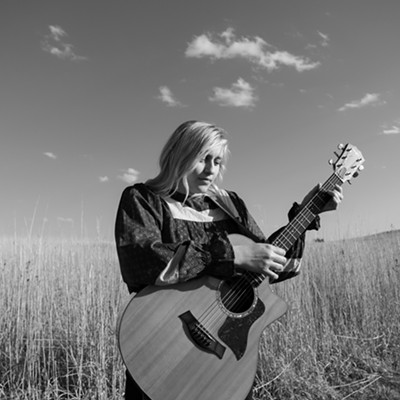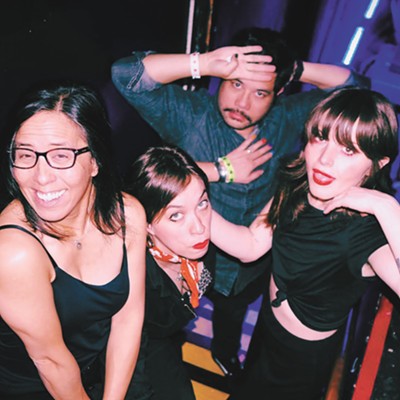The Metal and Mr. Kenney
[
{
"name": "Broadstreet - Instory",
"insertPoint": "5",
"component": "25846487",
"requiredCountToDisplay": "5"
},{
"name": "Broadstreet - Instory",
"insertPoint": "10",
"component": "25846487",
"requiredCountToDisplay": "10"
},{
"name": "Broadstreet - Instory",
"insertPoint": "15",
"component": "25846487",
"requiredCountToDisplay": "15"
},{
"name": "Broadstreet - Instory",
"insertPoint": "20",
"component": "25846487",
"requiredCountToDisplay": "20"
}
]
by LUKE BAUMGARTEN & r & & r & & lt;span class= & quot;dropcap & quot; & I & lt;/span & t's mid-evening and the maples are rustling gently. An early summer breeze has brought the first whiffs of chill to what has been a warm day. The dining area is shaded but bright, dappled sunlight still dancing off the tops of the century-old brick buildings to the north and south. With his back to Howard Street, Abe Kenney sits ensconced between a railing and his amp. Guitar in hand, he provides the tempo and melody for a half-full patio of diners as they tuck into their field roasts and fresh whitefish. As far as paved downtown alleyways go, it doesn't get more bucolic or serene than this.
It's the middle of a modest dinner rush at Mizuna. Kenney is dressed like the restaurant's servers, head to toe in dress casual black. His movements are economical. He's stoic and precise as he plucks his way though Mauro Giuliani's Grand Overture; stern as he wends his way through Isaac Albeniz' "Torre Bermeja." He seems the very model of a modern dinner musician.
He's meant to blend in, to become part of the scenery. Even a cursory glance, though, and things start to stand out. You notice his tattoo, a spurge of jagged arrows radiating out from a point on his forearm -- more chaos theory than eight-fold path. Then you see his guitar case, leaning against the amp, bearing stickers with similarly jagged lettering arranged symmetrically to resemble bat-like wings or the whirl of quick sand. They are the telltale marks of a death-metal acolyte. If you hadn't already, that's about when you realize that the music Abe Kenney is playing has a darkness to it. "Torre Bermeja" is spry in parts, but feels forlorn, even panicked at times. Another song in Kenney's repertoire is based on Francisco Goya's late-18th-century etching, "The Sleep of Reason Produces Monsters," a haunting scribble about what arises when men trade reason for superstition. When we invest our world with demons, Goya and Kenney suggest, we become monsters ourselves.
Kenney remembers driving through the mountains with his family as a child, while Edvard Grieg's Peer Gynt Suite played on the radio. The tale of trolls and witches as allegory for man's egoism gave him an interest in classical music -- its storytelling and its ability to evoke the monstrous. He discovered guitar in his adolescence and was always attracted to disparate forms of music. At first it was punk and classical. Eventually, punk gave way to ever more technical and dark forms of metal.
Society tends to put these forms at odds with one another, with classical guitar placed among the most august and timeless high art while metal is filed among the depths of recent pop culture. And Kenney doesn't disagree with that totally. The two usually sound worlds apart, he says. The human conditions they tackle, though, are the same.
"There was a lot of dark, often anti-religious imagery," Kenney says, "mixed with pointing out society's exploitation of people and the horrors of war and the disgusting aspects of all of that."
He finds composers from hundreds of years ago using similar tones to work through the same human tragedies and evils. "When you have a minor[-key], dissonant, religious piece, you can't help but picture apocalyptic or hellish imagery," Kenney says, invoking Bach specifically. "You can't help but imagine [the author] dealing with sin and the turmoil of religious devotion."
Kenney characterizes his current band, Obstruktor, as a thrash metal band straining at the limits of that genre. The band's vocalist, Wade Hampton, handles the band's lyrical content. "He's trying to say something from a personal perspective that relates to larger views of society," says Kenney. "We're trying to make art that deals with more than just typical anger."
That leaves Kenney to weave stories of his own into the band's lightning-fast churn. "Anne Akiko Meyers said that by studying old music, you get a more intense interest in new music," Kenney says, paraphrasing the concert violinist. "By studying old composers, I get new perspectives on metal and what I want to do in the future. Technical ideas, musical theories -- but also just the depth that classical has. There's always specific context for the music, an idea that represents image patterns. I'm always telling myself to make the music be more than just notes."
& lt;span class= & quot;dropcap & quot; & O & lt;/span & ne of the bigger differences between his work in metal and classical is the attention he receives. "I don't exactly play concerts on classical guitar," Kenney says. "I'm always background music." But that might be changing too.
Kenney's session at Mizuna last Thursday became more concert-like as the evening wore on. Though he didn't get much traction with the early crowd, by the time 9 pm hit, and the final wave of diners had begun to work its way through sea scallops and pasta Bolognese, about half the patio was visibly pleased their organic, pan-roasted chicken was being served with a dollop of pathos (lowercase pathos, that is. For selections from Kenney's defunct band, Pathos, you would need to have dined during the 8 o'clock hour).
During his last set of the night, sandwiched between a few livelier pieces, the Sturm und Drang of an older metal composition retooled for acoustic guitar set the space a-chill. The happier fare got appreciative claps; the metal left the patio near-silent. "That," said one apparent regular to his companion, with a wide smile, "was one of the death-metal pieces I was telling you about."
Obstruktor with Monolith and guests at the Zombie Room on Friday, June 27, at 9 pm. Price TBA. Call 747-5826.
Abe Kenney at Mizuna every Thursday from 6:30 pm to about 9:30 pm. No cover. Call 747-2004.
It's the middle of a modest dinner rush at Mizuna. Kenney is dressed like the restaurant's servers, head to toe in dress casual black. His movements are economical. He's stoic and precise as he plucks his way though Mauro Giuliani's Grand Overture; stern as he wends his way through Isaac Albeniz' "Torre Bermeja." He seems the very model of a modern dinner musician.
He's meant to blend in, to become part of the scenery. Even a cursory glance, though, and things start to stand out. You notice his tattoo, a spurge of jagged arrows radiating out from a point on his forearm -- more chaos theory than eight-fold path. Then you see his guitar case, leaning against the amp, bearing stickers with similarly jagged lettering arranged symmetrically to resemble bat-like wings or the whirl of quick sand. They are the telltale marks of a death-metal acolyte. If you hadn't already, that's about when you realize that the music Abe Kenney is playing has a darkness to it. "Torre Bermeja" is spry in parts, but feels forlorn, even panicked at times. Another song in Kenney's repertoire is based on Francisco Goya's late-18th-century etching, "The Sleep of Reason Produces Monsters," a haunting scribble about what arises when men trade reason for superstition. When we invest our world with demons, Goya and Kenney suggest, we become monsters ourselves.
Kenney remembers driving through the mountains with his family as a child, while Edvard Grieg's Peer Gynt Suite played on the radio. The tale of trolls and witches as allegory for man's egoism gave him an interest in classical music -- its storytelling and its ability to evoke the monstrous. He discovered guitar in his adolescence and was always attracted to disparate forms of music. At first it was punk and classical. Eventually, punk gave way to ever more technical and dark forms of metal.
Society tends to put these forms at odds with one another, with classical guitar placed among the most august and timeless high art while metal is filed among the depths of recent pop culture. And Kenney doesn't disagree with that totally. The two usually sound worlds apart, he says. The human conditions they tackle, though, are the same.
"There was a lot of dark, often anti-religious imagery," Kenney says, "mixed with pointing out society's exploitation of people and the horrors of war and the disgusting aspects of all of that."
He finds composers from hundreds of years ago using similar tones to work through the same human tragedies and evils. "When you have a minor[-key], dissonant, religious piece, you can't help but picture apocalyptic or hellish imagery," Kenney says, invoking Bach specifically. "You can't help but imagine [the author] dealing with sin and the turmoil of religious devotion."
Kenney characterizes his current band, Obstruktor, as a thrash metal band straining at the limits of that genre. The band's vocalist, Wade Hampton, handles the band's lyrical content. "He's trying to say something from a personal perspective that relates to larger views of society," says Kenney. "We're trying to make art that deals with more than just typical anger."
That leaves Kenney to weave stories of his own into the band's lightning-fast churn. "Anne Akiko Meyers said that by studying old music, you get a more intense interest in new music," Kenney says, paraphrasing the concert violinist. "By studying old composers, I get new perspectives on metal and what I want to do in the future. Technical ideas, musical theories -- but also just the depth that classical has. There's always specific context for the music, an idea that represents image patterns. I'm always telling myself to make the music be more than just notes."
& lt;span class= & quot;dropcap & quot; & O & lt;/span & ne of the bigger differences between his work in metal and classical is the attention he receives. "I don't exactly play concerts on classical guitar," Kenney says. "I'm always background music." But that might be changing too.
Kenney's session at Mizuna last Thursday became more concert-like as the evening wore on. Though he didn't get much traction with the early crowd, by the time 9 pm hit, and the final wave of diners had begun to work its way through sea scallops and pasta Bolognese, about half the patio was visibly pleased their organic, pan-roasted chicken was being served with a dollop of pathos (lowercase pathos, that is. For selections from Kenney's defunct band, Pathos, you would need to have dined during the 8 o'clock hour).
During his last set of the night, sandwiched between a few livelier pieces, the Sturm und Drang of an older metal composition retooled for acoustic guitar set the space a-chill. The happier fare got appreciative claps; the metal left the patio near-silent. "That," said one apparent regular to his companion, with a wide smile, "was one of the death-metal pieces I was telling you about."
Obstruktor with Monolith and guests at the Zombie Room on Friday, June 27, at 9 pm. Price TBA. Call 747-5826.
Abe Kenney at Mizuna every Thursday from 6:30 pm to about 9:30 pm. No cover. Call 747-2004.
















